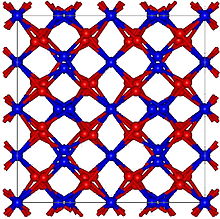Thallium(III) oxide

| |
| Names | |
|---|---|
| Other names
thallium trioxide, thallium sesquioxide
| |
| Identifiers | |
3D model (JSmol)
|
|
| ChemSpider | |
| EC Number |
|
PubChem CID
|
|
| UNII | |
| |
| |
| Properties[1] | |
| Tl2O3 | |
| Molar mass | 456.76 g/mol |
| Appearance | dark brown solid |
| Density | 10.19 g/cm3, solid (22 °C) |
| Melting point | 717 °C (1,323 °F; 990 K) |
| Boiling point | 875 °C (1,607 °F; 1,148 K) (decomposes) |
| insoluble | |
| +76.0·10−6 cm3/mol | |
| Structure | |
| Cubic, (Bixbyite) cI80[2] | |
| Ia3 (No. 206) | |
| Hazards | |
| GHS labelling:[3] | |
  
| |
| Danger | |
| H300+H330, H373, H411 | |
| P273, P301+P310+P330, P304+P340+P310, P314 | |
| NFPA 704 (fire diamond) | <imagemap>
File:NFPA 704.svg|80px|alt=NFPA 704 four-colored diamond poly 150 150 300 300 150 450 0 300 Health 4: Very short exposure could cause death or major residual injury. E.g. VX gas poly 300 0 450 150 300 300 150 150 Flammability 0: Will not burn. E.g. water poly 450 150 600 300 450 450 300 300 Instability 0: Normally stable, even under fire exposure conditions, and is not reactive with water. E.g. liquid nitrogen poly 300 300 450 450 300 600 150 450 Special hazards (white): no code desc none </imagemap> |
| Lethal dose or concentration (LD, LC): | |
LD50 (median dose)
|
44 mg/kg (oral, rat) |
Except where otherwise noted, data are given for materials in their standard state (at 25 °C [77 °F], 100 kPa).
| |
Thallium(III) oxide, also known as thallic oxide, is a chemical compound of thallium and oxygen. It occurs in nature as the rare mineral avicennite.[4] Its structure is related to that of Mn2O3 which has a bixbyite like structure. Tl2O3 is metallic with high conductivity and is a degenerate n-type semiconductor which may have potential use in solar cells.[5] A method of producing Tl2O3 by MOCVD is known.[6] Any practical use of thallium(III) oxide will always have to take account of thallium's poisonous nature. Contact with moisture and acids may form poisonous thallium compounds.
Production
It is produced by the reaction of thallium with oxygen or hydrogen peroxide in an alkaline thallium(I) solution. Alternatively, it can be created by the oxidation of thallium(I) nitrate by chlorine in an aqueous potassium hydroxide solution.[7]
References
- ^ Weast, Robert C., ed. (1981). CRC Handbook of Chemistry and Physics (62nd ed.). Boca Raton, FL: CRC Press. p. B156. ISBN 0-8493-0462-8..
- ^ Otto H.H.; Baltrasch R.; Brandt H.J. (1993). "Further evidence for Tl3+ in Tl-based superconductors from improved bond strength parameters involving new structural data of cubic Tl2O3". Physica C. 215 (1–2): 205. doi:10.1016/0921-4534(93)90382-Z.
- ^ GHS: Sigma-Aldrich 204617
- ^ http://www.handbookofmineralogy.org/pdfs/avicennite.pdf Handbook of Mineralogy
- ^ Phillips R. J.; Shane M. J.; Switzer J. A. (1989). "Electrochemical and photoelectrochemical deposition of Thallium(III) Oxide thin films". Journal of Materials Research. 4 (4): 923. Bibcode:1989JMatR...4..923P. doi:10.1557/JMR.1989.0923. S2CID 96808351.
- ^ D. Berry; R. T. Holm; R. L. Mowery; N. H. Turner & M. Fatemi (1991). "Thallium(III) Oxide by Organometallic Chemical Vapor Deposition". Chemistry of Materials. 3 (1): 72–77. doi:10.1021/cm00013a019.
- ^ Georg Brauer; Handbuch der präparativen anorganischen Chemie, Band 2, S.884; ISBN 3-432-87813-3 (in German)